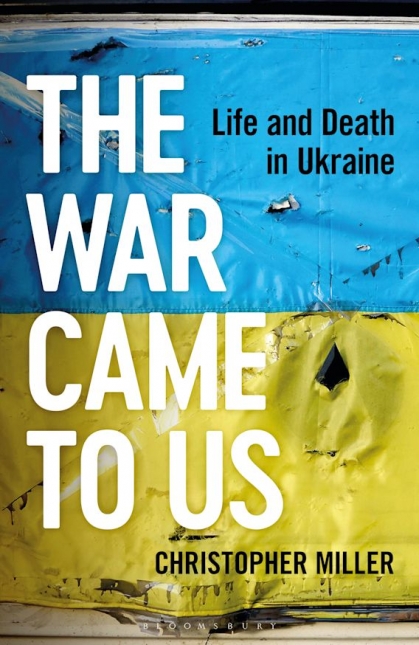The War Came to Us: Life and Death in Ukraine
- By Christopher Miller
- Bloomsbury Continuum
- 400 pp.
- Reviewed by Larry Matthews
- July 28, 2023
A diary-like account of a brave people’s resistance to Russian invasion.

Sadly, the Russian invasion of Ukraine has become mere background noise amid the daily news chatter. Atrocities, Ukraine’s offensive, and whatever is happening in Moscow get blended into two minutes of airtime on the networks and a scatter of stories on news sites along with all the other tragedies and outrages taking place across the globe.
But the story of Ukraine and its people versus the Russian bear has been years in the making, and if you want to know its history, you will do well to read Christopher Miller’s The War Came to Us. But be warned: This is as much Miller’s personal narrative as it is a tale of the beginning of a war. Readers not drawn to the history of this conflict might find the book a bit too diary-like in its day-to-day accounts of people and places.
Miller is an American journalist who has lived in Ukraine since 2010 when, as a Peace Corps volunteer taking a break from his career, he was assigned to duties in the Donbas — short for Donets Coal Basin — a region of Ukraine soon to be forcibly annexed by Russia and the scene of years of fighting before the full 2022 invasion.
This section of the book is important because it describes what daily life was like before the Russians attacked. It was a time when Ukrainians in the Donbas lived normal lives centering around family, jobs, friends, and food. Life was to be enjoyed even in the absence of paved roads.
In 2013, Miller gave up his Peace Corps gig (with its $260 monthly stipend) and returned to journalism. In 2014, Russia invaded Crimea and then the Donbas. Miller was there for all of it, but Ukraine was not ready for any of it. Its government was corrupt and weak, and its army was undermanned and undersupplied. When it turned to the West for help, there was no interest. Oleksandr Turchynov, Ukraine’s acting president at the time, told Miller, “They justified this to me by saying they do not want to provoke Putin and increase the risk of Russian aggression.”
So much for that strategy. Russia had Crimea, had managed to lock down a portion of the Donbas, and was making plans to invade the entire country in what Putin assumed would be a cakewalk. It was anything but. In an entry dated February 24, 2022, Miller writes:
“Early in the morning on the day that would change everything as we knew it, Ukraine’s leadership was fast asleep…Zelensky (the country’s new president) was startled awake by his phone ringing around 4:20 a.m. On the other end of the line was Interior Minister Denys Monastyrsky. ‘It’s begun,’ he told the president.”
The rest of the book is war reporting from the perspective of someone who knows the country and its people. Early in the invasion, the Russians attempted to capture an airport near Kyiv by sending in elite soldiers via helicopter. Yet a ragtag group of Ukrainians grabbed what weapons they could find, jumped into a pickup truck, and faced off against Russia’s best fighters. They shot down six of the helicopters, damaged others, and then blew holes in the runway to make it unusable for arriving Russian reinforcements.
Daytime fighting was heavy and brutal. By nightfall, Putin’s dream of a quick victory was dashed. It was Zelensky’s moment to shine. He refused American offers to get him out of Ukraine to safety. Instead, he stayed, swapped his suit for an army uniform, and told his people, “We are not afraid to defend our country, we are not afraid of the Russians.”
Ukrainians took down street signs to make it difficult for the Russians to know where they were. They put up signs inviting Russian soldiers to perform impossible sex acts on themselves. The owner of a women’s fashion shop, who had never fired a gun, announced, “I am a hunter of Russian occupiers.” Musician Andriy Khlyvnyuk, one of Ukraine’s biggest rock stars, quit a U.S. tour to put on a uniform, grab a rifle, and head to the front while wearing a Yankees cap. “This is my duty,” he said. He’s 42.
As the Ukrainians stunned the world with their bravery and heroism, many women and children tried to escape the danger. The main train station in Kyiv was packed with thousands of people fleeing Russian missiles. Tickets were obsolete. People threw whatever they had onto the trains and hoped to go west toward safety. Miller writes:
“Others were left stumped. Even more didn’t care and just tried to get on any train that was headed out of Kyiv. The situation was too much for some people. Many gave up and left or sat down and dropped their heads in their hands, accepting defeat.”
And then there were the atrocities. Miller writes that over a million Ukrainians were rounded up and sent to concentration camps, where families were broken up and shipped to other camps or to Russia, where their fates are today unknown. Russians also slaughtered civilians in the villages they captured and left the bodies to rot in the streets.
By the summer of 2022, the Russians were stalled, and Ukrainian civilians started to return to Kyiv. The people began to live their lives again despite an 11 p.m. nightly curfew. “It was another form of Ukrainian defiance,” writes Miller. “They weren’t going to live in fear and allow Russia the satisfaction of dictating their lives.”
Said one Ukrainian soldier, “If we cannot live, they win.”
Larry Matthews is the author of Take a Rifle from a Dead Man.

